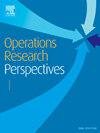优化不同协调结构下产品、材料和能源回收的闭环供应链库存系统
IF 3.7
4区 管理学
Q2 OPERATIONS RESEARCH & MANAGEMENT SCIENCE
引用次数: 0
摘要
日益认识到环境问题和采用扩大生产者责任对可持续工业的发展作出了重大贡献。逆向物流(RL)和闭环供应链(CLSC)是两个概念,涉及产品退货的有效管理,以尽量减少消费者的浪费。在本文中,作者建立了一个具有多种回收方案的CLSC系统库存管理的数学模型,包括产品、材料和能源回收。该模型是基于供应链结构开发的,其中包括供应商、制造商、零售商和材料回收设施(MRF)。所提出的模型有助于使供应链的利润最大化。采用分析和数值方法的混合方法来确定最优库存决策,包括订单周期时间和各方之间的发货数量。提出了分散决策结构(DDMS)和集中决策结构(CDMS)的解决程序。此外,模型还分析了利润分享机制。进行敏感性分析以调查模型在关键参数变化方面的行为,包括需求、产品退货、回收成本、消费后回收含量和能源可回收物品率。研究结果表明,在没有利润分成的情况下,清洁发展管理体系的利润最高。另一方面,实施利润分享机制可以为相关各方提供更公平的利润增长。在供应商处应用能量回收可以为系统带来经济效益。进一步讨论了能量回收对模型最优解的影响。本文章由计算机程序翻译,如有差异,请以英文原文为准。
Optimising a closed-loop supply chain inventory system with product, material, and energy recoveries under different coordination structures
The increasing recognition of environmental concerns and the adoption of Extended Producer Responsibility (EPR) have contributed significantly to the development of sustainable industries. Reverse logistics (RL) and closed-loop supply chain (CLSC) are two concepts that involve effective management of product returns to minimise consumer waste. In this paper, the authors develop a mathematical model for inventory management in CLSC systems with multiple recovery options, including product, material and energy recoveries. The model was developed based on a supply chain structure that includes a supplier, a manufacturer, a retailer, and a material recovery facility (MRF). The proposed model helps to maximise the profit of the supply chain. A hybrid method of analytical and numerical approaches is used to determine the optimal inventory decisions, including order cycle time and number of shipments between parties. Solution procedures are proposed for decentralised (DDMS) and centralised decision-making structures (CDMS). Furthermore, a profit-sharing mechanism is also analysed in the model. A sensitivity analysis is carried out to investigate the model's behaviour concerning variations in crucial parameters, including demand, product returns, recycling cost, post-consumer recycled content, and energy recoverable item rate. The results of this study show that the CDMS, without profit-sharing, generates the highest profits for the system. On the other hand, implementing a profit-sharing mechanism provides a fairer profit enhancement to the parties involved. Applying the energy recovery at the supplier results in financial benefits for the system. Additional discussion is carried out to understand the impact of energy recovery on the model's optimal solution.
求助全文
通过发布文献求助,成功后即可免费获取论文全文。
去求助
来源期刊

Operations Research Perspectives
Mathematics-Statistics and Probability
CiteScore
6.40
自引率
0.00%
发文量
36
审稿时长
27 days
 求助内容:
求助内容: 应助结果提醒方式:
应助结果提醒方式:


